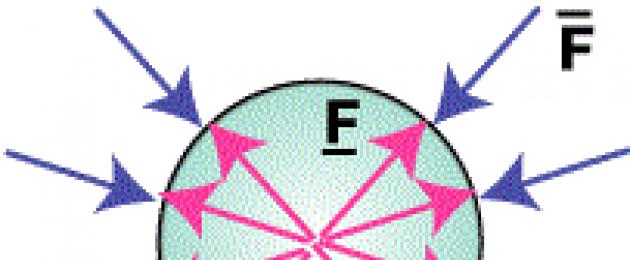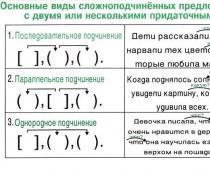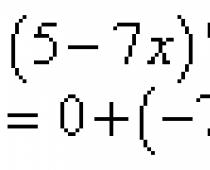All bodies that surround us consist of a colossal large number of atoms or molecules, that is, they are macroscopic systems
Mechanical properties of bodies
Mechanical properties of bodies are determined by their internal structure, state, chemical composition, the study of which goes beyond the framework of mechanics, therefore they are studied in other branches of physics. In mechanics, when considering real bodies, depending on the conditions of a specific problem, they use simplified models: a material point, an absolutely rigid body, and others.
Material point(MT) is called a body, the size and shape of which can be neglected in a given specific physical problem. The criterion for this is that the characteristic distances that the body travels in the process of a given movement (the scale of movement, we denote by L) should be orders of magnitude (at least 1-2 orders of magnitude) greater than the characteristic dimensions of the body. Thus, the criterion that physical body can be considered MT will be the fulfillment of the condition. The term "material point" itself, as it were, emphasizes that we neglect the size of the body, but at the same time it is a physical object with mass. In this sense, it would be more correct to use the term "point mass", similar to how it is done in electrostatics, where the term "point charge" is used.
Read similar essays:
In physics, the concept of order of magnitude is very important: as this concept should be used even for the correct definition of MT, we will briefly recall this definition. Such a comparison through an order of magnitude makes it possible to correctly establish whether this body can be considered a material point in a given specific physical problem or not. Easier - you can neglect the size of the body in comparison with the characteristic distances passing the body in the process of a given movement.
Now it is obvious that in the process of the Earth's movement around the Sun it can, of course, be considered a material point. In the process of movement of bodies along earth surface... or near the Earth (the movement of satellites), the Earth can no longer be considered a material point, and vice versa, we will compare the sizes of these bodies with the sizes of the Earth in each specific task.
Any body or system of bodies is studied in mechanics, it can be considered as a system of material points. For this, it is necessary to conditionally break all the bodies of the system into a sufficiently large number of parts, such that the dimensions of each of these parts are incomparably small in comparison with the dimensions of the bodies themselves.
An absolutely rigid body is called a body, the distance between - any two points of which remains unchanged. Such a model can be used in problems in which the deformations of the body can be neglected. In fact, an absolutely rigid body is an MT system, rigidly interconnected.
Read similar essays:
Body movements in physics
Any movement of an absolutely rigid body can be decomposed into two main types of movement - translational and rotational.
Translational motion- this is a movement in which any straight line connecting two arbitrary points of this body, drawn in a moving body, remains parallel to itself. For example, a piston in a cylinder of an engine or a heat engine, an elevator car, when lowering and raising, move progressively. It will be shown below that at each moment of time the velocities and accelerations of all points of the body during translational motion will be the same, which means that to describe such a motion of a rigid body, it is sufficient to consider the motion of any one of its points.
Material point an infinitesimal body with a mass, the shape of which can be neglected. This is the simplest, idealized body, the geometrical dimensions of which are small, and only 3 coordinates are needed to define it in space. The rotation of the material point is also neglected. It is believed that inside a material point, there are no forces. It does not shrink, does not stretch, but is absolutely elastic. The mass of a material point is unchanged in time, and does not depend on any other conditions.
Figure 1 - replacement of a body with a material point.
The concept of a material point is introduced into mechanics to simplify the description of the motion of material bodies. A body of arbitrary shape, which is already elastic and can perform both translational and rotational motion. It can also deform. That is, individual points of the body, in addition to moving with the body, also move relative to it. In the general case, the motion of a body of arbitrary shape is rather complex and difficult to describe.
Just to simplify the description of such a motion, the concept of a material point is introduced. It is believed that it has the mass of the described body, but infinitely small in size. In this case, only translational motion... The material point is used to define the center of mass. This is precisely the point that has a mass distributed over the volume of the body.

Figure 2 - material point.
It is clear that you cannot just take and replace the body of a complex handicap with an extremely simplified model. This requires the fulfillment of certain conditions. The main one, of which, is: the size of the body must be many times less than the distance traveled by it. Also important factor the conditions of the experiment and the expected result are influencing the possibility of replacing a real body with a simplified model.
Let us assume that, according to the conditions of the experiment, it is necessary to determine the time it takes for the train to travel the distance from point A to point B, knowing its speed. In this case, we do not care what shape the train has, and how many cars the train consists of. Since we know its speed. It can be represented as a material point. But if we need to determine the air resistance exerted by the train when moving at high speeds. It makes no sense to represent it as a material point. Since the result of this experiment depends on the shape of the train.
And what to do in the case when the body cannot be represented as a material point. Due to the fact that it has a complex shape. And its individual parts move not only with linear, but also with angular velocity. Then the body is represented as a sum of separate material points. Which will make only forward motion.
Material point
Material point(particle) - the simplest physical model in mechanics - an ideal body, the dimensions of which are equal to zero, the dimensions of the body can also be considered infinitely small in comparison with other dimensions or distances within the assumptions of the problem under study. The position of a material point in space is defined as the position of a geometric point.
In practice, a material point is understood as a body with mass, the size and shape of which can be neglected when solving this problem.
With a rectilinear motion of a body, one coordinate axis is sufficient to determine its position.
Peculiarities
The mass, position and speed of a material point at any given moment in time completely determine its behavior and physical properties.
Consequences
Mechanical energy can be stored by a material point only in the form of kinetic energy of its motion in space, and (or) potential energy of interaction with the field. This automatically means the inability of a material point to deformations (only an absolutely rigid body can be called a material point) and rotation around its own axis and changes in the direction of this axis in space. At the same time, the model of motion of a body described by a material point, which consists in changing its distance from a certain instantaneous center of rotation and two Euler angles, which set the direction of the line connecting this point to the center, is extremely widely used in many branches of mechanics.
Restrictions
The limited application of the concept of a material point is seen from the following example: in a rarefied gas at high temperature the size of each molecule is very small compared to the typical distance between molecules. It would seem that it can be neglected and the molecule can be considered a material point. However, this is not always the case: vibrations and rotations of a molecule are an important reservoir of the "internal energy" of a molecule, the "capacity" of which is determined by the size of the molecule, its structure and chemical properties... In a good approximation, a monatomic molecule (inert gases, metal vapors, etc.) can sometimes be considered as a material point, but even in such molecules at a sufficiently high temperature, excitation of electron shells is observed due to collisions of molecules, followed by emission.
Notes (edit)
Wikimedia Foundation. 2010.
- Mechanical movement
- Absolutely solid body
See what "Material point" is in other dictionaries:
MATERIAL POINT is a point with mass. In mechanics, the concept of a material point is used in cases where the size and shape of a body do not play a role in the study of its motion, but only mass is important. Almost any body can be considered as a material point, if ... ... Big Encyclopedic Dictionary
MATERIAL POINT- a concept introduced in mechanics to designate an object, which is considered as a point with a mass. The position of M. of t. In pr ve is defined as the position of the geom. points, which greatly simplifies the solution of problems in mechanics. In fact, the body can be considered ... ... Physical encyclopedia
material point- A point with mass. [A collection of recommended terms. Issue 102. Theoretical Mechanics. USSR Academy of Sciences. Scientific and Technical Terminology Committee. 1984] Topics theoretical mechanics EN particle DE materialle Punkt FR point matériel ... Technical translator's guide
MATERIAL POINT Modern encyclopedia
MATERIAL POINT- In mechanics: an infinitely small body. Dictionary of foreign words included in the Russian language. Chudinov A.N., 1910 ... Dictionary of foreign words of the Russian language
Material point- MATERIAL POINT, a concept introduced in mechanics to denote a body, the size and shape of which can be neglected. The position of a material point in space is defined as the position of a geometric point. The body can be considered material ... ... Illustrated Encyclopedic Dictionary
material point- a concept introduced in mechanics for an object of infinitesimal dimensions and mass. The position of a material point in space is defined as the position of a geometric point, which simplifies the solution of problems in mechanics. Almost any body can ... ... encyclopedic Dictionary
Material point- geometric point with mass; material point is an abstract image of a material body with mass and no dimensions ... The beginnings of modern natural science
material point- materialusis taškas statusas T sritis fizika atitikmenys: angl. mass point; material point vok. Massenpunkt, m; materieller Punkt, m rus. material point, f; point mass, f pranc. point masse, m; point matériel, m ... Fizikos terminų žodynas
material point- A point with a mass ... Polytechnic Terminological Explanatory Dictionary
Books
- A set of tables. Physics. Grade 9 (20 tables),. Educational album of 20 sheets. Material point. The coordinates of the moving body. Acceleration. Newton's laws. Law universal gravitation... Straight and curved movement. Body movement along ...
MATERIAL POINT- a model concept (abstraction) of classical mechanics, denoting a body of vanishingly small dimensions, but possessing a certain mass.
On the one hand, a material point is the simplest object of mechanics, since its position in space is determined by only three numbers. For example, three Cartesian coordinates of the point in space where our material point is located.
On the other hand, a material point is the main reference object of mechanics, since it is for it that the basic laws of mechanics are formulated. All other objects of mechanics - material bodies and environments - can be represented in the form of one or another set of material points. For example, any body can be "cut" into small parts and each of them can be taken as a material point with a corresponding mass.
When it is possible to "replace" a real body with a material point in the formulation of the problem of body motion, depends on the questions to which the solution of the formulated problem must answer.
There are various approaches to the question of using the material point model.
One of them is empirical. It is believed that the material point model is applicable when the dimensions of the moving bodies are negligible in comparison with the magnitude of the relative displacements of these bodies. As an illustration, one can cite Solar system... If we assume that the Sun is a fixed material point and consider it to act on another material point-planet according to the law of universal gravitation, then the problem of the motion of a point-planet has a known solution. Among the possible trajectories of motion of a point there are those on which Kepler's laws are fulfilled, empirically established for the planets of the solar system.
Thus, in describing the orbital motions of the planets, the material point model is quite satisfactory. (However, the construction of a mathematical model of such phenomena as solar and lunar eclipses requires taking into account the real sizes of the Sun, Earth and Moon, although these phenomena are obviously associated with orbital motions.)
The ratio of the diameter of the Sun to the diameter of the orbit of the nearest planet - Mercury - is ~ 1 · 10 –2, and the ratio of the diameters of the planets closest to the Sun to the diameters of their orbits is ~ 1 ÷ 2 · 10 –4. Can these numbers serve as a formal criterion for neglecting the body size in other problems and, therefore, for the acceptability of the material point model? Practice shows that it is not.
For example, a small bullet size l= 1 ÷ 2 cm the distance flies L= 1 ÷ 2 km, i.e. the ratio, however, the flight path (and the range) significantly depends not only on the mass of the bullet, but also on its shape, and on whether it rotates. Therefore, even a small bullet, strictly speaking, cannot be considered a material point. If in the tasks of external ballistics the projectile is often considered a material point, then this is accompanied by reservations of the series additional conditions usually empirically taking into account the real characteristics of the body.
If we turn to astronautics, then when spacecraft(SC) is injected into a working orbit, in further calculations of its flight trajectory, it is considered a material point, since no changes in the spacecraft shape have any noticeable effect on the trajectory. Only sometimes, when correcting the trajectory, it becomes necessary to ensure accurate orientation of jet engines in space.
When the descent compartment approaches the surface of the Earth at a distance of ~ 100 km, it immediately "turns" into a body, since it depends on how "sideways" it enters the dense layers of the atmosphere whether the compartment will deliver the astronauts and the returned materials to the desired point on the Earth. ...
The material point model turned out to be practically unacceptable for describing the movements of such physical objects of the microworld as elementary particles, atomic nuclei, electrons, etc.
Another approach to the issue of using the material point model is rational. According to the law of change in the momentum of the system, applied to an individual body, the center of mass C of the body has the same acceleration as some (let's call it equivalent) material point, which is acted upon by the same forces as on the body, i.e.
Generally speaking, the resulting force can be represented as a sum, where it depends only on and (radius vector and speed of point C), and on the angular velocity of the body and its orientation.
If F 2 = 0, then the above relation turns into the equation of motion of an equivalent material point.
In this case, the movement of the center of mass of the body is said to be independent of the rotational movement of the body. Thus, the possibility of using the material point model receives a rigorous mathematical (and not just empirical) justification.
Naturally, in practice, the condition F 2 = 0 rarely and usually F 2 No. 0, but it may turn out that F 2 is in a sense small compared to F one . Then we can say that the model of an equivalent material point is some approximation when describing the motion of a body. An estimate of the accuracy of such an approximation can be obtained mathematically, and if this estimate turns out to be acceptable for the "consumer", then replacing the body with an equivalent material point is permissible, otherwise such a replacement will lead to significant errors.
This can also take place when the body is moving translationally and from the point of view of kinematics it can be "replaced" by some equivalent point.
Naturally, the model of a material point is not suitable for answering questions such as "why does the moon face the Earth with only one side of it?" Similar phenomena are associated with the rotational movement of the body.
Vitaly Samsonov
Material point
Material point(particle) - the simplest physical model in mechanics - an ideal body, the dimensions of which are equal to zero, the dimensions of the body can also be considered infinitely small in comparison with other dimensions or distances within the assumptions of the problem under study. The position of a material point in space is defined as the position of a geometric point.
In practice, a material point is understood as a body with mass, the size and shape of which can be neglected when solving this problem.
With a rectilinear motion of a body, one coordinate axis is sufficient to determine its position.
Peculiarities
The mass, position and speed of a material point at any given moment in time completely determine its behavior and physical properties.
Consequences
Mechanical energy can be stored by a material point only in the form of kinetic energy of its motion in space, and (or) potential energy of interaction with the field. This automatically means the inability of a material point to deformations (only an absolutely rigid body can be called a material point) and rotation around its own axis and changes in the direction of this axis in space. At the same time, the model of motion of a body described by a material point, which consists in changing its distance from a certain instantaneous center of rotation and two Euler angles, which set the direction of the line connecting this point to the center, is extremely widely used in many branches of mechanics.
Restrictions
The limited application of the concept of a material point is seen from such an example: in a rarefied gas at a high temperature, the size of each molecule is very small compared to the typical distance between molecules. It would seem that it can be neglected and the molecule can be considered a material point. However, this is not always the case: vibrations and rotations of a molecule are an important reservoir of the "internal energy" of a molecule, the "capacity" of which is determined by the size of the molecule, its structure and chemical properties. In a good approximation, a monatomic molecule (inert gases, metal vapors, etc.) can sometimes be considered as a material point, but even in such molecules at a sufficiently high temperature, excitation of electron shells is observed due to collisions of molecules, followed by emission.
Notes (edit)
Wikimedia Foundation. 2010.
See what "Material point" is in other dictionaries:
A point that has mass. In mechanics, the concept of a material point is used in cases where the size and shape of a body do not play a role in the study of its motion, but only mass is important. Almost any body can be considered as a material point, if ... ... Big Encyclopedic Dictionary
A concept introduced in mechanics to designate an object, which is considered as a point with a mass. The position of M. of t. In pr ve is defined as the position of the geom. points, which greatly simplifies the solution of problems in mechanics. In fact, the body can be considered ... ... Physical encyclopedia
material point- A point with mass. [A collection of recommended terms. Issue 102. Theoretical Mechanics. USSR Academy of Sciences. Scientific and Technical Terminology Committee. 1984] Topics theoretical mechanics EN particle DE materialle Punkt FR point matériel ... Technical translator's guide
Modern encyclopedia
In mechanics: an infinitely small body. Dictionary of foreign words included in the Russian language. Chudinov A.N., 1910 ... Dictionary of foreign words of the Russian language
Material point- MATERIAL POINT, a concept introduced in mechanics to denote a body, the size and shape of which can be neglected. The position of a material point in space is defined as the position of a geometric point. The body can be considered material ... ... Illustrated Encyclopedic Dictionary
A concept introduced in mechanics for an object of infinitesimal dimensions and mass. The position of a material point in space is defined as the position of a geometric point, which simplifies the solution of problems in mechanics. Almost any body can ... ... encyclopedic Dictionary
Material point- geometric point with mass; material point is an abstract image of a material body with mass and no dimensions ... The beginnings of modern natural science
material point- materialusis taškas statusas T sritis fizika atitikmenys: angl. mass point; material point vok. Massenpunkt, m; materieller Punkt, m rus. material point, f; point mass, f pranc. point masse, m; point matériel, m ... Fizikos terminų žodynas
material point- A point with a mass ... Polytechnic Terminological Explanatory Dictionary
Books
- A set of tables. Physics. Grade 9 (20 tables),. Educational album of 20 sheets. Material point. The coordinates of the moving body. Acceleration. Newton's laws. The law of universal gravitation. Straight and curved movement. Body movement along ...
- In contact with 0
- Google+ 0
- OK 0
- Facebook 0








